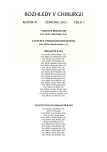Breast reconstruction by autologous fat transfer
Authors:
O. Měšťák 1; M. Zimovjanová 2
Authors‘ workplace:
Klinika plastické chirurgie, 1. lékařská fakulta Univerzity Karlovy v Praze
přednosta: Doc. MUDr. J. Měšťák CSc.
1; Onkologická klinika, 1. lékařská klinika Univerzity Karlovy v Praze
přednosta: Prof. MUDr. L. Petruželka, CSc.
2
Published in:
Rozhl. Chir., 2012, roč. 91, č. 7, s. 373-377.
Category:
Original articles
Overview
Introduction:
Autologous fat tissue transfer has recently become extremely popular in the field of plastic and reconstructive surgery. Fat represents a filling material with ideal properties – it naturally incorporates into tissues and it is autologous, and therefore 100% biocompatible. An increasing number of publications describe the regenerative properties of autologous fat tissue, especially when used in soft tissue with post-radiation damage. The aim of this article is to describe our experience with fat grafting in breasts.
Materials and methods:
An autologous fat grafting operation consists in 3 phases – harvesting of fat tissue, its processing, and application of the graft. Fat harvesting is similar to classic liposuction. Common methods of fat tissue processing are centrifugation and the use of the PureGraft filter bags. The most important precondition for a favourable result of the operation is the correct graft application.
Results:
In the period between March 2011 and January 2012, we used this fagrafting to perform surgical breast reconstruction in 15 patients; 8 patients with a breast deformity after partial mastectomy and radiation, 2 patients after complete mastectomy, 2 patients after complete mastectomy reconstructed with the additional use of external expansion, 2 patients after implant reconstruction presenting with subsequent deformity and 1 patient with pectus excavatum. The patients were followed up for 3–12 months. Long-term retention of the graft was considered good.
Conclusion:
By use of fatgrafting, we can achieve excellent results with minimal risk of complications in reconstructive breast surgery. Autologous fat has plenty of advantages when compared to other biomaterials. It is absolutely biocompatible and able to regenerate the surrounding tissue.
Key words:
fat grafting – autologous fat transfer – breast reconstruction – calcification – breast cancer
Sources
1. Joseph M. Handbuch der kosmetik. 1912, Leipzig: Veit & Co.
2. Ersek RA. Transplantation of purified autologous fat: a 3-year follow-up is disappointing. Plast Reconstr Surg 1991;87(2): 219–27; discussion 228.
3. Coleman SR, Saboeiro AP. Fat Grafting to the Breast Revisited: Safety and Efficacy. Plastic and Reconstructive Surgery 2007; 119(3):775–785 10.1097/01.prs.0000252001.59162.c9.
4. Carraway JH, Mellow CG. Syringe aspiration and fat concentration: a simple technique for autologous fat injection. Ann Plast Surg 1990;24(3):293–6;discussion;297.
5. Coleman SR. Long-term survival of fat transplants: controlled demonstrations. Aesthetic Plast Surg 1995;19(5):421–5.
6. Rohrich RJ, Sorokin ES, Brown SA. In search of improved fat transfer viability: a quantitative analysis of the role of centrifugation and harvest site. Plast Reconstr Surg 2004;113(1):391–5;discussion 396–7.
7. Coleman SROV. Structural fat grafts: the ideal filler? Clin Plast Surg 2001;28(1):111–9.
8. Coleman SR. Structural fat grafting: more than a permanent filler. Plast Reconstr Surg 2006;118(3 Suppl):108S–120S.
9. Strem BM, Hedrick MH. The growing importance of fat in regenerative medicine. Trends Biotechnol 2005;23(2):64–6.
10. Sensebe L et al. Mesenchymal stem cells for clinical application. Vox Sang 2010; 98(2):93–107.
11. Rigotti G et al. Clinical treatment of radiotherapy tissue damage by lipoaspirate transplant: a healing process mediated by adipose-derived adult stem cells. Plast Reconstr Surg 2007;119(5): 1409–22;discussion;1423–4.
12. Lin K et al. Characterization of adipose tissue-derived cells isolated with the Celution system. Cytotherapy 2008;10(4):417–26.
13. Zimmerlin L et al. Stromal vascular progenitors in adult human adipose tissue. Cytometry A, 2010. 77(1): p.22–30.
14. Yoshimura KH, Suga H, Eto H. Adipose-derived stem/progenitor cells: roles in adipose tissue remodeling and potential use for soft tissue augmentation. Regen Med 2009;4(2):265–73.
15. Gimble JM, Katz AJ, Bunnell BA. Adipose-derived stem cells for regenerative medicine. Circ Res 2007;100(9):1249–60.
16. Kato H et al. Reversible adipose tissue enlargement induced by external tissue suspension: possible contribution of basic fibroblast growth factor in the preservation of enlarged tissue. Tissue Eng Part A 2010;16(6):2029–40.
17. Veber M et al. Radiographic findings after breast augmentation by autologous fat transfer. Plast Reconstr Surg 2011;127 (3):1289–99.
18. Rubin JP et al. Mammographic Changes After Fat Transfer to the Breast Compared With Changes After Breast Reduction: A Blinded Study. Plast Reconstr Surg 2012.
19. Albarenque SM, Zwacka RM, Mohr A. Both human and mouse mesenchymal stem cells promote breast cancer metastasis. Stem Cell Res 2011;7(2):163–71.
20. Kucerova L et al. Interaction of human adipose tissue-derived mesenchymal stromal cells with breast cancer cells. Neoplasma 2011;58(5):361–70.
21. Pearl RA, Leedham SJ,Pacifico MD. The safety of autologous fat transfer in breast cancer: Lessons from stem cell biology. Plast Reconstr Aesthet Surg 2011.
22. Zimmerlin L et al. Regenerative therapy and cancer: in vitro and in vivo studies of the interaction between adipose-derived stem cells and breast cancer cells from clinical isolates. Tissue Eng Part A 2011;17(1–2):93–106.
23. Rigotti G et al. Determining the oncological risk of autologous lipoaspirate grafting for post-mastectomy breast reconstruction. Aesthetic Plast Surg 2010;34(4):475–80.
24. Petit JY et al. The oncologic outcome and immediate surgical complications of lipofilling in breast cancer patients: a multicenter study – Milan-Paris-Lyon experience of 646 lipofilling procedures. Plast Reconstr Surg 2011;128(2):341–6.
Labels
Surgery Orthopaedics Trauma surgeryArticle was published in
Perspectives in Surgery

2012 Issue 7
Most read in this issue
- Surgical treatment of complicated hepatic echinococcosis in two Bulgarian citizens at two surgical departments in the Czech Republic
- Segmental duodenectomy (D3, D4) for angiosarcoma
- Descending necrotising mediastinitis – surgical management
- Endosonography of the oesophagus in the diagnosis and treatment of oesophageal tumours
